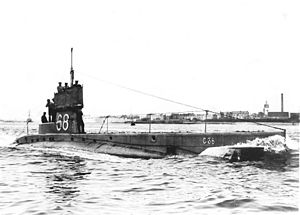This article needs additional citations for verification. (February 2013) |
 HMS C38
| |
| Class overview | |
|---|---|
| Name | C-class |
| Builders | Vickers, Barrow; HM Dockyard Chatham |
| Operators | |
| Preceded by | B class |
| Succeeded by | D class |
| Subclasses |
|
| In commission | 30 October 1906–1922 |
| Completed | 38 |
| Lost | 10 |
| Retired | 28 |
| General characteristics | |
| Type | Submarine |
| Displacement |
|
| Length | 143 ft 2 in (43.64 m) |
| Beam | 13 ft 6 in (4.11 m) |
| Propulsion | 600 hp (450 kW) Vickers petrol engine, 200 hp electric motor, single propeller |
| Speed |
|
| Range |
|
| Complement | 16 |
| Armament | 2 × 18-inch (450 mm) torpedo tubes (2 torpedoes) |
The British C-class submarines were the last class of petrol engined submarines of the Royal Navy and marked the end of the development of the Holland class in the Royal Navy. Thirty-eight were constructed between 1905 and 1910 and they served through World War I.
With limited endurance and only a ten per cent reserve of buoyancy over their surface displacement, they were poor surface vessels, but their spindle shaped hull made for good underwater performance compared to their contemporaries.